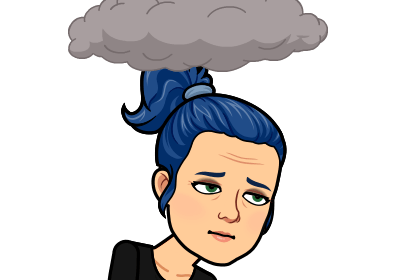Tag: Reflective Practice
Protected: INF506 Assessment 2 – Evaluation and Reflection
Describing and Analysing Educational Resources Modules 4 & 5 & Reflection on ETL505
The manner of locating resources by (A) natural language subject headings, (B) controlled vocabulary subject headings within libraries, or (C) standardised classification numbering systems such as ‘Dewey Decimal Classification’ (DDC), or the Library of Congress Classification (LCC,) (or in the form of genrefication of a collection) shows that the vocabulary for describing the ‘subject’ of a resource are all paramount to FRBR element of ‘location’ of a resource.
According to Hider (2018) subject headers, thesauri, classifications are all deceptively subjective, laborious, costly and difficult to maintain, while natural language can be too relative, varied and ambiguous (Hider & Harvey, 2008). So, how do we describe the subject of an item in a (universal) way that our patrons can locate what they need?
An ABC of important terms and their definitions from the modules and readings:
(A) Natural Language / Uncontrolled Vocabularies
- Uncontrolled vocabulary: subject headings &/or descriptors created from natural language, derived from the information resources/authors which are often more up to date, common terms that are more familiar for users; Natural language / uncontrolled vocabularies better enable the tasks of keyword searching, records enhancement and automatic indexing (Hider & Harvey, 2008, p.154-155).
- Key word searching: the method by which a user searches the library collection on the information retrieval system, usually via the title, author, subject, series or a mixture of these (Hider & Harvey, 2008, p. 155).
- Boolean operations: search terms that improve the chance of a match as they include word proximity and word adjacency (Hider & Harvey, 2008, p.155); (See also below “Boolean logic: different terms are combined in a single search using ‘AND’, ‘OR’ and ‘NOT’ (Hider, 2018, p.178).”
- Truncation: the abbreviation of search terms using the # symbol; improving the chance of successful searching because the number of results increases (Hider & Harvey, 2008, p. 155).
- Bibliographic records enhancement: utilising natural vocabulary search functions to include the subject indicative key words within resource abstracts, contents and summaries (Hider & Harvey, 2008, p.156-157).
- Abstracts: A brief, accurate, unambiguous, objective representation of the contents of a document or presentation, usually found in research journal databases; They are usually written after an article has been created and research finalised, and can be indicative / descriptive (indicating specific information found in the article), informative (summarising the data in the article), or critical (making a judgement about the quality of the article contents) (Hider & Harvey, 2008, p.159-160).
- Social tagging: Social tagging is indexing performed by controllers and end users; Similar to truncation, particular key words can be given a # or ‘tag’, rather than being added by a controller, the tag is assigned by a multitude of users, which is then searchable, particularly in social media; Social tagging is not regulated and can be inconsistent (Hider, 2018, p.85-86).
- Folksonomies: a natural vocabulary wordplay opposing controlled taxonomy, folksonomies are indexing vocabularies created by end-users, recommended to be used to complement professional indexing (Hider, 2018, p.86-87).

(B) Subject Headings / Controlled Vocabularies
-
- Objectivism: The view that one may need to discover knowledge, but that all knowledge is ‘set’ and universal (Hider, 2018, p. 189).
- Subjectivism: The view that knowledge is (and is therefore organised) based on various perspectives within culture and societies (see also warrant, below) (Hider, 2018, p.189).
- Controlled vocabularies: Standardised / prescribed sets of metadata values to help index, identify or display a collection (or both); Sometimes referred to as knowledge organisation systems (Hider, 2018, p.175).
- Subject / subject header: a particular knowledge domain which is not always easily identified and not objective, and is, in fact a matter of individual subjective judgement (Hider, 2018, p.175-176); in which (according to LCSH) the knowledge domain / subject is covered by at least 20% of the resource content (Hider, 2018, p.183).
- Subject description: careful analysis of the content of a resource (Hider, 2018, p. 177).
- LCSH: Library of Congress Subject Headings; A standardised (but continually growing and cross-referenced) list of subject headings used to index the content of all english pubic/academic library collections; The initial term heading (followed by a string of sub-divisions) are created as ‘MARC’ fields that can be searched within ‘OPAC’ (Hider, 2018, p.179-180).
- LCGFT: Library of Congress Genre / Form Terms for Library and Archival Materials which “covers ‘artistic and visual works, cartographic materials, “general” materials (e.g. dictionaries, encyclopaedias), law materials, literature, moving images (films and television programs), music, non-musical sound recordings (primarily radio programs), and religious materials’ (Library of Congress, 2018, in Hider, 2018, p.183).
- SCISshl: Schools Catalogue Information Service (SCIS) subject headings list in Australia / New Zealand provided by Education Services Australia.
- ScOT: Schools Online Thesaurus, descriptors used in support of the SCISshl (headings) (Hider, 2018, p188). Schools Online Thesaurus (ScOT) provides controlled vocabulary subject access to online curriculum content relevant to Australian and New Zealand schools and has also been provided by Education Services Australia.
- Subject thesaurus: a structured, post-coordinated, automated, retrieval, indexing (rather than classifying) compilation tool which uses cross-referenced descriptors in support of the subject headings (Hider, 2018, p.185;190); The standard for the creation of subject thesauri is set by the ISO Standard Thesauri for Information Retrieval (Hider, 2018, p.188); See also ScOT (above), ERIC Thesaurus, STW Thesaurus for Economics, NASA Thesaurus, National Agricultural Library Thesaurus, Aquatic Sciences and Fisheries Thesaurus, Australian Health Thesaurus, Australian Thesaurus of Education Descriptors, British Education Thesaurus, Art and Architecture Thesaurus, & the Thesaurus for Graphic Materials (Hider, 2018, p.187-188).
- Warrant: a subjective (see subjectivism above) way to specify the most likely thesaurus terms that will be used as descriptors for the subject headings, eg. literary warrant or user warrant (Hider, 2018, p.185).
- Facet analysis: the method for studying how the facets (and sub-facets) of particular field of knowledge are structured in concept or labelled in terminology (Hider, 2018, p.185-186).
- Index term: a subject heading’s ‘descriptor’ used for cross referencing purposes (Hider, 2018, p.176).
- Cross-referencing: identified by codes like: UF (use for); BT (broader term); NT (narrower term); and RT (related term) (Hider, 2018, p.181).
- Derived indexing: takes/derives words ‘naturally’ from the document (Hider, 2018, p.176).
- Assigned indexing: takes words from somewhere else, typically from a controlled/standardised indexing vocabulary, and assigns them to represent the document’s content.
- Summary level indexing: main topics are described to represent the resource as a whole (Hider, 2018, p.176).
- Standardised classification scheme: vocabulary used for placing items in a specific location or area on a shelf so that it may be easily located (Hider, 2018, p. 175).
- Controlled vocabulary / controlled subject vocabulary: subject headings lists, subject thesauri, or subject classification schemes that can be qualitative or quantitative (Hider, 2018, p.175).
- Pre-coordination: the strings of terms representing the sub-concepts are coordinated prior to indexing and searching, e.g. Birds-Australia; This method is less restrictive (Hider, 2018, p.177-178).
- Post-coordination: the strings of terms representing the sub-concepts stand alone and are then individually searched, e.g. Australia. Birds; This method is more precise (Hider, 2018, p.177-178).
- Boolean logic: different terms are combined in a single search using ‘AND’, ‘OR’ and ‘NOT’ (Hider, 2018, p.178).
(C) Subject Classification Schemes
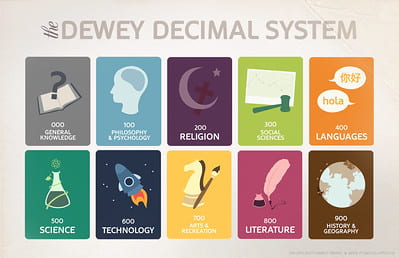
-
- Subject classification schemes: careful arrangement of the subject headings into groups/classes using (numerical) notations rather than descriptors (Hider, 2018, p.189-190). Subject classification schemes (using subject division – see ‘100 divisions of DDC’ and ‘LCC scheme overview’ charts below) and subdivision disciplines are a good for classification bibliographically, but if used unilaterally for placing resources on shelves, can result in resources being scattered across the space (Hider, 2018, p.193-195); Furthermore, no other numbers than those provided in the DDC ‘Schedules’ or the 6 ‘Tables’ (see ‘6 Tables of DDC’ image below) may be used; While subject classification is usually for labelling and shelving purposes, they can also be vitally important for searching digital collections, digital museums, musical or audio collections (however, not archival collections as these must be organised by date) (Hider, 2018, p.200-201).
- LCC, ADDC15 & DDC23, UDC: These are subject classification schemes (note above) used in the call number element; They are the Library of Congress Classification, the Abridged Dewey Decimal Classification, currently edition 15 (ADDC15) and Dewey Decimal Classification, edition 23 (DDC23) and the Universal Decimal Classification (UDC) (Hider, 2018, 192-193; 196; 198).
- Call number: The entire notation sequence of numbers &/or letters uniquely identifying a resource, making it easier to locate or find on the shelves (Hider, 2018, p.197).
- Disciplines of subject classification schemes: The synthetic means by which the subject classification scheme (such as DDC, UDC, or LCC – used by Trove) is organised, similar to subject headings, but is more aligned with the resource’s purpose, rather than what the resource is about or how it will be used; (Hider, 2018, p.193)
- DDC: Dewey Decimal Classification;
- LCC: Library of Congress Classification using disciplines and a hierarchical notation system, similar to the DDC, except the LCC uses letters and numbers; the LCC and subject headings were created in 1897 based on the ‘Cutter Expansive Classification’/’Cutter numbers’ which create a specific position for each item within a class (see the ‘Summary of LCC’ image below) further expanding using ‘auxiliary tables’ (Hider, 2018, p.196-197).
- UDC: Universal Decimal Classification; a French first attempt at universal bibliographic control across all recorded knowledge (not just American based knowledge) particularly science and technology converted to English in 1980 but still not widely used in English speaking countries; (Hider 2018, p. 198).
- Subject classification schemes: careful arrangement of the subject headings into groups/classes using (numerical) notations rather than descriptors (Hider, 2018, p.189-190). Subject classification schemes (using subject division – see ‘100 divisions of DDC’ and ‘LCC scheme overview’ charts below) and subdivision disciplines are a good for classification bibliographically, but if used unilaterally for placing resources on shelves, can result in resources being scattered across the space (Hider, 2018, p.193-195); Furthermore, no other numbers than those provided in the DDC ‘Schedules’ or the 6 ‘Tables’ (see ‘6 Tables of DDC’ image below) may be used; While subject classification is usually for labelling and shelving purposes, they can also be vitally important for searching digital collections, digital museums, musical or audio collections (however, not archival collections as these must be organised by date) (Hider, 2018, p.200-201).

![Hider, P. (2018). The 6 Tables of DDC [Image] in Information Resource Description / Creating and Managing Metadata. Vol. Second edition. Facet Publishing. p195](https://thinkspace.csu.edu.au/croe/files/2020/10/Hider-P.-2018.-The-6-Tables-of-DDC-Image-in-Information-Resource-Description -Creating-and-Managing-Metadata.-Vol.-Second-edition.-Facet-Publishing.-p195.png)
 (Hider, 2018, p.196)
(Hider, 2018, p.196)
Thoughts and musings before and after completing the final assessment:
- In modules 4 & 5, while reading Hider (2018) p. 201-205, I tried to understand how a taxonomy is different from a classification system versus an ontology system, but sorry, my brain would not absorb it and I feared I had reached max capacity for Hider.
- Throughout this session, I could not manage the multitude of forum posts for this subject. It was far more than any other subject (and I’ve completed all but 1 elective at this point) and was very minimal in actual ‘discussion’ – more used as a place for students to post their answers to the tasks. I recommend the powers that be consider using a series of (perhaps unmarked but compulsory) ‘quizzes’ or something for the tasks other than forum discussions, particularly if the cohort is medium to large in future.
- When I started this degree I expected to do this class first. I think I am glad that I didn’t. I can see the relevance, but the content is very academic and I’m glad I did it (almost) last. In the beginning of this class I felt like I was filling my brain with things that would be taking up what is very valuable and limited realestate, and I only just changed my mind after completing the second assessment. (This may be compounded by the fact that I am not presently, nor have I ever, worked full time as a teacher librarian and everything I am trying to learn from copious amounts of reading is not yet applicable to my real world context.)
- As I read (and read) the first assessment feedback, the main thing that I learned was that the lecturer and the text book author for the course were both very very much smarter than I. (This is certainly, without question, definitely true. Yet, I think it is a reflection on the course that I feel this way. Is it far too academic, far too wordy, far too heavy in reading, and, although I got a credit in the first assessment, far too thorough in the marking? Or am I too arrogant? Food for thought.)
- My issue with Research in Practice was exactly the same issue that I had with Describing and Analysing Education Resources and that was: I have spent most of the course trying to dig myself out of the (growth mindset) learning pit and felt out of my comfort zone the entire duration. I was reading and reading and reading. I was reading the texts, the modules and the forum posts (although, as previously stated, found very little with which to engage). I was posting blog posts with my reading notes. I was doing the exercises and checking my answers (generally way off!). I took two weeks off work (on either side of my 2 week prac) to ensure I completed the final assessment, meaning I had a month off work (and financially suffered with my family). And in the end, I learned a fair bit and would consider what I learnt, worth the struggle.
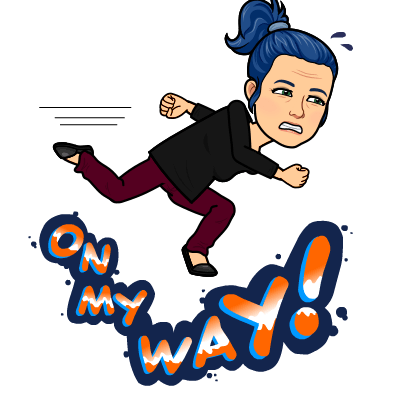
On my way Bitmoji - Finally, now that I’ve done the course and basically finished the degree, I pleased to say that I feel like I understand the concepts and could manage cataloguing. (Enjoying cataloguing, however, might be a fair way into the distance)…Also, I still think Hider (and a few times in the learning modules) need to correct all of the many end of sentence prepositions in the next edition of the textbook. Please. Thank you.
References
Hider, P. (2018). Information Resource Description : Creating and Managing Metadata: Vol. Second edition. Facet Publishing.
Hider, P., & Harvey, R. (2008). Organising knowledge in a global society : Principles and practice in libraries and information centres. ProQuest Ebook Central https://ebookcentral.proquest.com
Protected: Reflecting on the overall ETL507 study visit experience (August-September 2020)
Learning by and from doing – before, during and after study visits and workplace placements
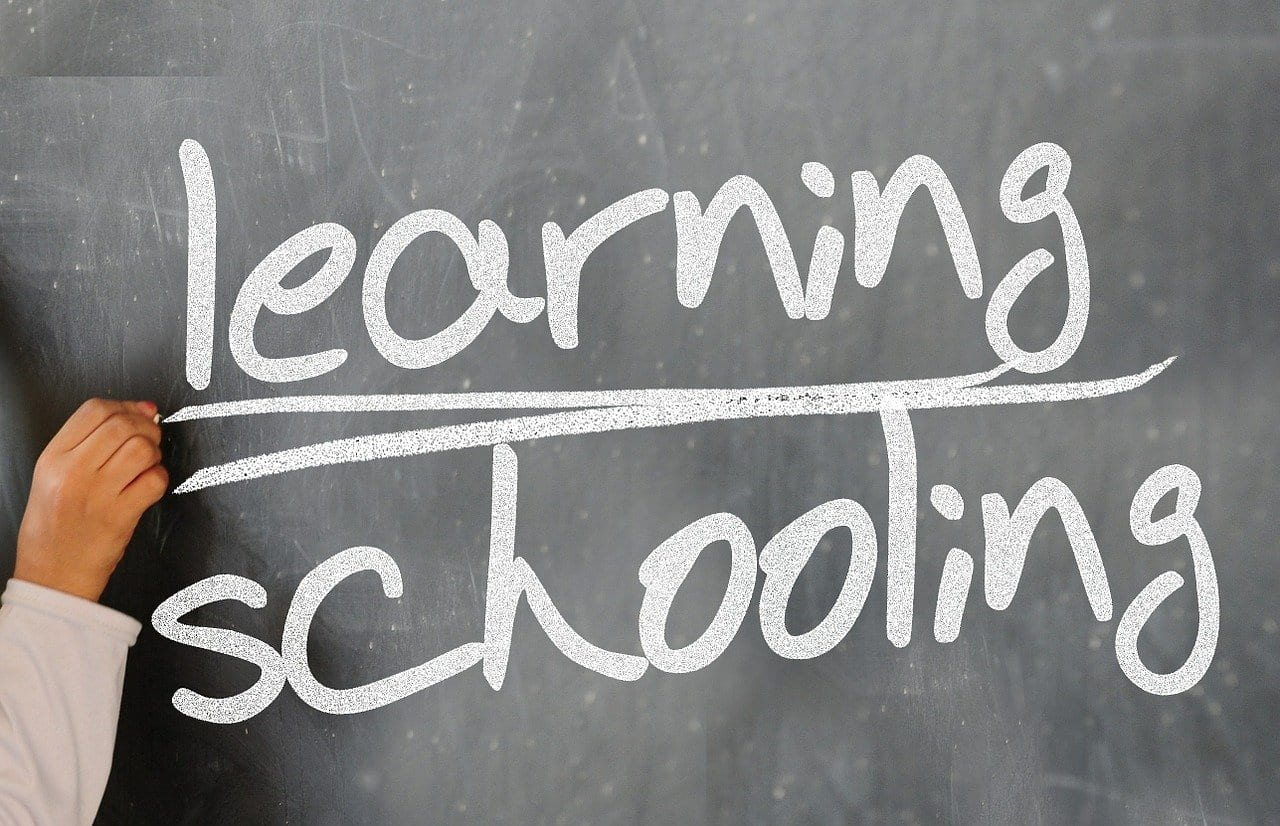
Before the 4 day study visit (SV) or (10 day) workplace placement (WPL)
- Enrol in ETL507 Session 2 & Session 3 2020; Read all modules; Read suggested list in references; Attend all webinars; Take SV pre-quiz by 3 August 2020; and take WPL pre-placement quiz by 17 August 2020; (COMPLETE).
- Read ‘Foundation knowledge skills & attributes’ PDF by ALIA, ASA & RIMPA; Join LinkedIn; (COMPLETE).
- Watch CSU WPL webinar and read presentation slides for how to write goals and CV; (COMPLETE).
- Attend 4 study visits (see schedule) and reflect on the experiences; (COMPLETE)
- Create a draft portfolio outline during the week of 7 September 2020.
- Submit a SV report by 18 -20 September 2020. (COMPLETE).
- Create SMAER goals for prac experience: 1. To observe and gain an understanding how the library prioritises meeting the expectations of a variety of stakeholders including the council and broader local community; 2. To learn how the library identifies and investigates and satisfies the needs and information behaviours of its users (including individuals, communities, organisations and businesses) through creation, collaboration and partnerships; and 3. To learn how the library evaluates information sources, services and products to determine their relevance to the needs of their users (ALIA goals). (COMPLETE).
- Draft a CV using the strategies recommended in the webinar; Prepare an up-to-date 2020 CV (to upload later on InPlace – remember to name the file: RoeETL507CV); (COMPLETE).
- Consider timing for WPL (must be 4 weeks after proposal submitted but 2 weeks before end of ETL507);
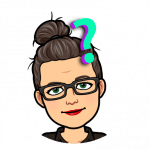 (Thoughts: so long as COVID-19 doesn’t require me to look after my children again, I should be able to do the placement any time. I’d prefer to do it during school holidays as I am a casual teacher and would lose income by doing it during the term, but will be open to the host’s needs). (COMPLETE).
(Thoughts: so long as COVID-19 doesn’t require me to look after my children again, I should be able to do the placement any time. I’d prefer to do it during school holidays as I am a casual teacher and would lose income by doing it during the term, but will be open to the host’s needs). (COMPLETE). - Select host and 2 back-up hosts; Check do not call list & review contact guidelines; (e.g. Bega Valley Public Library; 2 other ‘virtual’ placements from Canberra libraries which I missed out on due to COVID-19?). (COMPLETE).
- Contact host(s) – remember to ask if they have 10 min to talk, and if so, explain “I’m a student with the SIS, CSU, doing the MaEd. TL course and I’d like to ask about possibly doing a professional placement of 10 days with a qualified information professional supervisor for my workplace learning.” If they agree, then explain my interests / goals. If they are still in agreement, propose a timeframe for completing the placement (e.g. any 10 days between 19 Sept 2020 – 15 Jan 2021). (COMPLETE).
- Provide links to host for employer expectations ; insurance; and CSU student requirements; If a host asks for a ‘Placement Agreement,’ contact the WPL admin team; (COMPLETE).
- Understand the host requirements and discuss with the host if they can: a. provide a supervisor that is a professionally recognised information professional with an information/librarian qualification (as well as the job title), b. that they agree to design, develop and support an appropriate program to meet my goals and c. that their collection and services reflect the size, nature and needs of the community; (COMPLETE)
- Obtain the ‘agency’ contact details, suggested roster and supervisor contact details for the placement proposal; (COMPLETE)
- Write and submit placement proposal & CV (including my SMART goals) to InPlace using the guide provided, registering for WPL; this must be submitted 4 weeks prior to WPL or no later than Mon. week 14 of ETL507’s 1st session, which for me is 12 October 2020; (COMPLETE – although I only have 1 week before the agency want me to do the placement).
- Once the WPL team have contacted the host and approved the placement, make arrangements with host regarding a program for what I could do for them during the placement, supervisor details & organise my work or other commitments. (COMPLETE)
During
- WPL to be completed by 15 Jan 2021 or 2 weeks following the end of the placement. (COMPLETE)
- Eat, sleep, & be prepared; Be on time; Dress appropriately; Be curious-figure out the best way to learn from an unfamiliar setting; Ask questions with good timing and respect with the position that I’m a novice/student; Be open minded to different ideas that might challenge my self confidence and ‘sense of self’; Follow workplace protocols and WH&S requirements; Be a team player; Be receptive to feedback; Always use personal devices appropriately; Consider CSU values and be: insightful, inclusive, impactful, inspiring; Be aware of and behave according to ‘ALIA Employer Roles & Responsibilities in Ed. & P.D.’ policy and CSU’s policies on: ‘Make a good first impression,‘ ‘Student Charter,’ ‘Student misconduct rule 2020‘; ‘Harassment & Bullying Prevention policy‘; ‘Anti-racism policy‘; and ‘Academic Integrity policy‘ (being honest, fair & responsible). (COMPLETE)
- During the placement tasks, keep in the forefront the outcomes for ETL507: Learning with the head (cog.), hands (skills), heart (affective) & body (phys.); Understand the wider library community and its practices; Evaluate the role/functions of libraries; Apply theory into practice reflectively; (COMPLETE)
- Report emergencies to the CSU WPL team and my course contact: Liz Derouet (including accidents, hazards, criminality, fires, harassment, abuse or events of nature/’acts of god’); (COMPLETE)
- Continually reflect on the experience, using the ‘what, so what, now what’ model recommended in Brown (2017); See also Hampe, N. (2013) and Hull, B., Churkovich, M., Outred, C. & Turner, D. (2011); Describe, discuss & reflect on issues, such as: how the library interacts with users, who are the users, how easy is it to locate information about the library; how different is it in fact vs from my assumptions; what information is imparted by the library; and what services do they offer? (COMPLETE)
- Have a placement review meeting with the supervisor, discuss my placement, use this structure for completing the placement review meeting and fill in the placement review report; Thank the organisation for their support! (COMPLETE)
After
- Think about my blog; Consider digital portfolio applications; Develop a portfolio for submission by 18 Jan 2021;
- Ensure paperwork and assessments are complete, including a study visit report (COMPLETE), placement proposal (COMPLETE); C.V. (COMPLETE); a professional placement report (assessment) & signed placement review meeting record (no more than 2 weeks after placement and/or no later than 1 Feb 2021 = 23 Oct 2020 for me) (COMPLETE); and my completed portfolio by 18 Jan 2021;
- It is recommended that I join (yearly): ALIA ($95), ASA ($75), RIMPA ($106) as well as maintain my NESA accreditation ($100), and pay back my HECS.
 Thoughts: $375 a year plus HECS repayments might be a bit much to ask as I’m working part time as a casual…maybe there is a job out there for me…
Thoughts: $375 a year plus HECS repayments might be a bit much to ask as I’m working part time as a casual…maybe there is a job out there for me…
| 1 | Pre Study Visit Quiz | SY/US | 03-Aug-2020 | Complete |
| 2 | Study Visit Report | SY/US | 18/20-Sep-2020 | Complete |
| 3 | Pre Placement Quiz | SY/US | 17-Aug-2020 | Complete |
| 4 | Placement Proposal and CV | SY/US | No later than 12-Oct-2020 | Complete |
| 5 | Professional Placement Report | SY/US | No later than 1-Feb-2021 or 2 weeks after prac (23-Oct-2020) | Complete |
| 6 | Professional Reflective Portfolio | SY/US | 18-Jan-2021 |
References and further reading
Bolton, G. (2010). Reflective practice: Writing and professional development. Los Angeles: Sage.
Brown, N. (2017). Reflective model according to Rolfe et al. http://www.nicole-brown.co.uk/reflective-model-according-to-rolfe/ (Rolfe, G., Freshwater, D. and Jasper, M. (2001). Critical reflection in nursing and the helping professions: a user’s guide. Basingstoke: Palgrave Macmillan).
Chancellor, R. L. (2018). Crossing the globe: Why studying abroad is essential to the future of LIS education. 6, 59 (3), 41-52.
Edmonson, R. (2018) Is film archiving a profession yet? A reflection – 20 years on. Synoptique. 6(1), 14-22. (Annotated by Christy Roe).
Hampe, N. (2013). Reflective Practice and Writing: a Guide to Getting Started. Retrieved from: http://www.alia.org.au/sites/default/files/documents/Reflective.Practice.Writing.Guide20130409JB.pdf
Hull, B., Churkovich, M., Outred, C. & Turner, D. (2011). Librarians as reflective practitioners. In Hull, B., Churkovich, M., Outred, C. & Turner, D., Understandiing Librarians: Communication is the issue (pp.105-113), Oxford: Chandos Publishing. doi: 10.1016/B978-1-84334-615-9.50012-8
Reynolds, S., Carroll, M. & Welch, B. (2016) Engaging with our future: the role of educators, practitioners, professional associations and employing organisations in the co-creation of information professionals. Australian Library Journal 65 (4), 317-327. doi: 10.1080/00049670.2016.1235529
Schon, D. (2008). The reflective practitioner: How professionals think in action. New York: Basic Books.
What is Digital Citizenship?

Before I fully delve into the ETL523 Digital Citizenship content, I need to briefly determine what I think digital citizenship is, in terms of being an educator of (young) children.
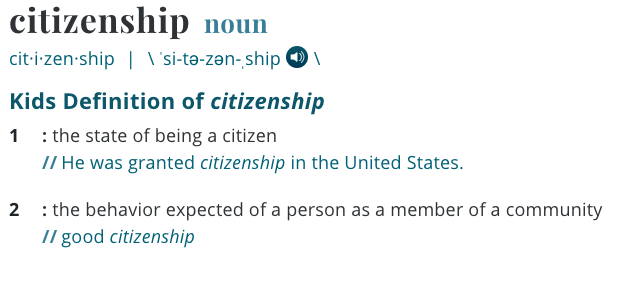
Digital citizenship is primarily an add on to citizenship. We must behave in a civilised manner in life, both face to face (citizenship) and online/electronically (digital citizenship). If at first students have no concept of citizenship
– that is, a communal bond and respect for living and working harmoniously together for the greater good –
then they will similarly have no concept of digital citizenship (living and working harmoniously together for the greater good electronically).
Positive Behaviour for Learning (PB4L), Social Emotional Learning (SEL), citizenship/ethics should be integral to every aspect of our 2020 teaching day. We must help students regulate through consistent SEL, relate to them via whole school programs like PB4L, so that we may reason / rationalise with them with lessons on citizenship and ethics (these being Dr Bruce Perry’s 3 R’s as provided by Beacon House, 2020).
Furthermore, I would add that as teachers our rationalisations / lessons must all be able to be reflected upon and evaluated and revised continually using some form of collegial quality teaching standards, such as the Quality Teaching Framework (QTF)…perhaps this could be my contribution to ETL523, to link Digital Learning Environments to the QTF…
The below notes are from reading ETL523 Module 1 ‘What is digital citizenship’:
Digital citizenship therefore, is not just about keeping students safe online, or giving students the skills or devices to access technology. It is helping students become productive members of an digital (learning) environment…digital citizens of a globally digital social society. This is supported by the video by ISTE, (2018) Rethinking digital citizenship.
Furthermore, as detailed by Greenhow (2010), Ribble, Bailey, and Ross (in their book, Digital Citizenship in Schools, ISTE, 2007), consider the 9 elements of digital citizenship to be: digital etiquette, digital communication, digital access, digital literacy, digital commerce, digital law, digital rights and responsibilities, digital health and wellness, and digital security.
Digital citizenship requires technical, individual, social, cultural and global awareness, which must be considered by teachers in the practical terms of students’ understanding the concepts of: safety, privacy, copyright, fair use and legal compliance, etiquette and respect, habits of learning (responsible, reliable management of online activity), literacy and fluency. This is best demonstrated by the Enlightened digital citizenship model of Davis & Lindsay (2012):
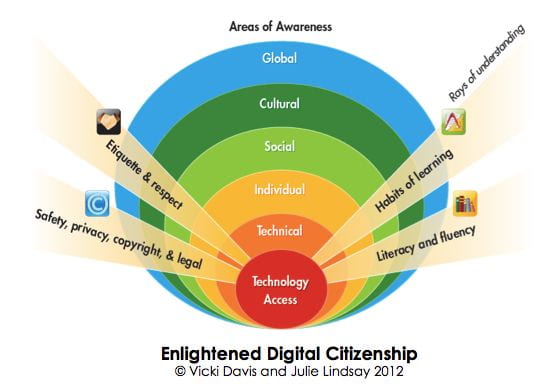
References
Beacon House, (2020). Dr Bruce Perry’s 3 R’s. Retrieved from https://beaconhouse.org.uk/resources/
Greenhow, C. (2010). New concept of citizenship for the digital age. Learning & Leading with Technology, 37(6), 24-25.
ISTE. (2018, October 11). Rethinking digital citizenship. Retrieved from https://youtu.be/iwKTYHBG5kk.
Lindsay, J., & Davis, V. (2012). Flattening classrooms, engaging minds: Move to global collaboration one step at a time. Allyn and Bacon. Chapter 5: Citizenship. (available on CSU DOMS as a downloadable PDF)
Merriam-Webster, (2020). Definition of Citizenship. [Image]. Retrieved from https://www.merriam-webster.com/dictionary/citizenship
Protected: ETL504 Assessment 2 Part B – Reflection
Case Study 2 & 3 Reflections of Group Work

Case Study 2 – online meeting discussion / chat
I found the format for the chat a little disconcerting. When it was time to have my ‘say’ about the issues in the case study, I felt intense anxiety at how fast everyone’s comments were flashing up. I wanted to read them, not only to learn but also to make sure I wasn’t doubling up or saying something totally off the wall compared to what everyone else was saying but it was just too fast. So, I had to just look quickly at my notes and put up a short comment.
Where to from here:
If given the chance in the future, I will try to have something ready that I can just cut and paste quickly.
Case Study 3 – group post
I tried to utilise the strategies for leadership that I felt were important, not in terms of me being the leader, but in terms of what it would take for us to work well together as a group. I wanted to take the time at the beginning to get to know each person in the group.
However, the resulting responses (and almost entire lack thereof) showed that the other members of the group (bar one and myself) did not want to or were not able to take the time to offer any information about themselves. They seemed to simply want to either 1. make it known that they expected us to pick a leader off the cuff (supposably them?) or 2. appropriate time and responsibilities based on their external commitments.
I suppose I went wrong by oversharing or putting nearly everyone off in the way my ‘about me’ was worded in the link to my blog page. Perhaps getting to know each other is seen as a waste of time when everyone else simply wanted to ‘get down to business.’
Overall, I was left feeling out of sorts. As if I’ve missed some social cue, or misread the situation and am now outside the group. I feel as though I’ve set myself apart, rather than made sure I led from the middle, as I had hoped.
Where to from here:
For now, I will let it go and hope for a better result next time. Maybe I will just start smaller with simply a few sentences about myself and hope that others feel comfortable sharing more as we go along…
Reflecting on Organisational, Managerial and Leadership Theory 2.2-2.3
REFLECTIVE: “Derive happiness in oneself from a good day’s work, from illuminating the fog that surrounds us.” Henri Matisse
(Matisse n.d.)

It is amazing to me how we all grow up getting used to the amazing structures of the past without acknowledging their significance in our present. Much like the ancient buildings showing through the fog in the image from Simon Matzinger (above) so are the structures of organisational, managerial and leadership theory from past and present all around us.
If we don’t take the time to reflect on and recognise the structures that exist and influence our actions, we are but living in a fog. Thus, I’ve spent a lot of time and brain energy this week on the subject…and as I peer into the fog of the history and research, I fear I have but scratched the surface.
I’m not alone in my experiences of poor leadership/management/organisational structure. I’m sure many of us in our mid 30’s and beyond have some war stories to tell…in my very first officially paid position in a grocery store, the front end manager and his assistant stole nearly $40 000 from the company (which became evident in the scandal that erupted when I accidentally took home a pack of $1 bills in my apron and nobody noticed until I turned it in the next day). Was this because they lacked the necessary leadership ‘trait‘ of integrity but it was assumed that they had that trait when they were hired? Was this because of the organisational structure being ‘divisional’ (Kokemuller, 2017) without actually any vision or sharing of vision?
I had quite a few retail positions in my youth. In one position, I worked in a bookstore and the manager was passive aggressive and controlling, possibly anal retentive…he would put dusting skills into our performance appraisals as a critique and used a texta to draw outlines of where he wanted the office supplies to go. Everyone on staff was very friendly and hard working and we all just managed ourselves and the store with very little need for input from him. Was this because of his leadership skill or ‘traits’ and lack thereof? Was he in an environment that called for a ‘transformational’ leader but he was stuck in the ‘autocratic’ leadership mindset? Did he have a lack of control over us that made him feel irrelevant?
POWER: “Part of the task of the leader is to make others participate in his leadership. The best leader knows how to make his followers actually feel power themselves, not merely acknowledge his power” … “Leadership is not defined by the exercise of power but by the capacity to increase the sense of power among those led. The most essential work of the leader is to create more leaders” Mary Parker Follet (in Janse 2019).
In my office worker years, I learnt that I am good at being an office worker, in that I can do the work to a very high standard. I can type and shuffle papers and find quick and cost effective solutions to most any problem. I watched as many of my white, male colleagues received promotions despite the fact that I was doing the same job much better than they had been. And, oh boy, do I hate the lack of humour, the dearth of beauty, the monotony and, most of all, the sense that I was not doing anything that improved the world. Why are offices so often designed in the ‘divisional’ (Kokemuller, 2017) way? Why do people who socialise really well receive promotions when people who do their jobs really well remain in those positions – is it because some people are perceived to have more ‘statesmen’ ‘traits’ and that makes them more suited to leadership positions? How actually important is it to be able to do the job of the subordinate well prior to or while being a leader of that subordinate? Is it part of being more efficient within the ‘scientific‘ management theory?
When I became a teacher (in the Australian education system), my first impression still rings true: schools try to mimic what they believe business structures to be like. A parody of sorts. A reproduction. However, there is one key difference in the business structure of education: our shared goal to improve outcomes for the children at our schools, and indeed, thus improve the world. We shouldn’t limit ourselves to the machine or divisional organisation structures. We have it in our capacities to aim for the ‘professional’ and ‘innovative’ structures (Kokemuller, 2017). Let’s lead the way for business, not the other way around!
VISION: “The most successful leader of all is the one who sees another picture not yet actualised. (They see) the things which are not yet there… Above all, (they) should make (their) co-workers see that it is not (the leader’s) purpose which is to be achieved, but a common purpose, born of the desires and the activities of the group” Mary Parker Follet (in Janse 2019).
I’ve been told, at various times in my teaching career, that I got my degree the ‘easy’ way or ‘through the back door’ by doing an early childhood degree. I sometimes hear little snippets about where I should be placed within a school because of this also…as if I am not capable of working with older students because my university training 12 years ago, despite the fact that as a casual teacher I’ve worked with ages 3 to 14. Even in the first case study for ETL504, I was curious why one of the ’employees’ needed her degree specialisation to be pointed out. Was it because we have to treat early childhood trained educators differently because they aren’t as clever as the rest? Is this part of the bureaucratic and ‘divisional,’ ‘machine’ organisational structures, or are we identifying the early childhood specialisation as a means to create a ‘professional’ structure (Kokemuller, 2017)?
APPRECIATION: “Unity, not uniformity, must be our aim. We attain unity only through variety. Differences must be integrated, not annihilated, not absorbed” Mary Parker Follet (in Janse 2019).
As written in my previous post on this blog (see below) entitled “Creating a Collaborative Climate – The Triple C’s” on the 21st of May 2019, we are expected to collaborate when so much of the stuff behind the scenes or ‘beneath the fog’ isn’t set up effectively. The amount of control we have over the organisational set up is limited, those old buildings have been around for too long and are stronger than one person. However, we can work on building a collaborative climate within those organisational structures. In addition to the items listed in my Triple C blog post, I would add team building to the list.
INVENTION “Conflict is resolved not through compromise, but through invention” Mary Follet Parker (in Janse 2019).
Team building is something in which office human resources managers are proficient and schools would do well to take note of their advice. Trust, communication, conflict resolution and productivity are increased when team building occurs (Al-Bakri 2017). In my Triple C blog post, I recommended and I still recommend that instead of ‘meetings’ where information is disseminated, we could host ‘yarning circles’ as recommended by The Salvation Army (Worthing, 2018). While I am not promoting and am not religious, I respect the ideas recommended and would love to host a staff yarning circle in my library with my team. I’d also like to investigate team building activities such as those provided by beyond the boardroom or other companies in Australia.
Until then, here is my previous blog post on workplace climate change:
References
Al-Bakri, S. (2017). Why every organisation should embrace team activities. Retrieved from https://www.hrmonline.com.au/social-media/organisation-embrace-team-activities/
Janse, B. (2019). Mary Parker Follett. Retrieved from toolshero: https://www.toolshero.com/toolsheroes/mary-parker-folett/
Kokemuller, N. (2017). Mintzberg’s five types of organizational structure. In Hearst Newspapers: Small business. Retrieved from http://smallbusiness.chron.com/mintzbergs-five-types-organizational-structure-60119.html
Matisse, H. (n.d.) Henri Matisse Quotes, BrainyQuote.com. Retrieved from https://www.brainyquote.com/quotes/henri_matisse_140869
Worthing, S. (2018). The Yarning Circle. Retrieved from https://others.org.au/features/the-yarning-circle/
